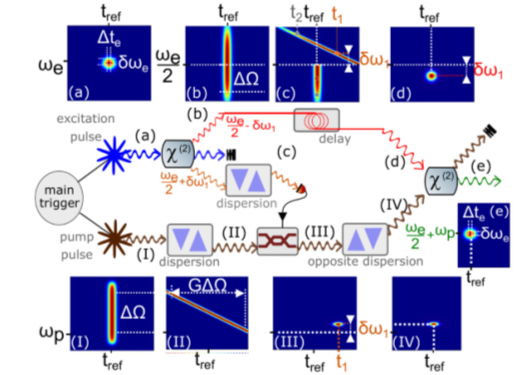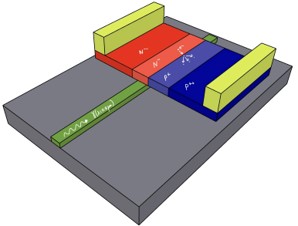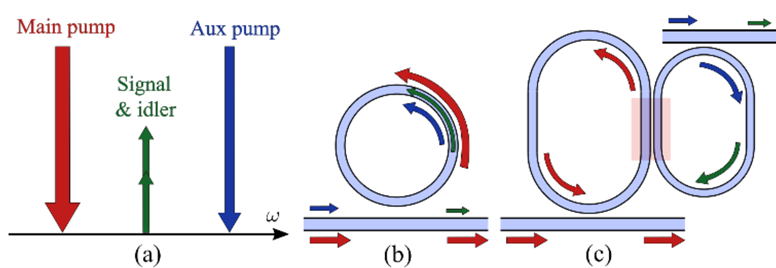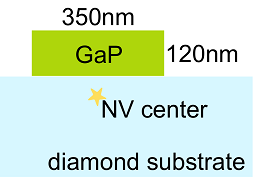Quantum optics: we create , transform and measure quantum states of light for application in quantum computing, sensing and communication
Single photon source via active multiplexing of herladed single photons
- The probability of outputting one and only one photon must reach near unity. This probability must account for losses and the possibility of multi photon emission.
- The emitted photons should always be identical (undistinguishable) and it should not be a problem to build several sources outputting identical photons.
We work on a system relying on coherent four wave mixing and single photon heralding to generate wavelength tunable photons complying with those requirements.

Team participants
- Prof. Serge Massart
- Nischal Gujarel
Funding
- Equipement and research grants (FNRS)
- Fond d’encouragement à la recherche (ULB)
Single photon detection
In optical quantum computing, the read out of information relies primarly on the detection of single photons. Currently, even if the absorption can take place on a photonic chip, the whole readout (amplifier, discriminator,...) system is deported. This results in a nanosecond latency (in the best case scenario) incompatible with the kind of optical feedback desired. Moreover, the current state-of-the-art technology for single photon detections relies on superconduction and requires cryogenic operation. This later limitation is one of the major bottleneck faced while attempting to scale up quantum photonics circuits. 
We work on silicon avalanche photodiodes (SPADs) whose geometry can be adjusted thanks to nanophotonics Ics. These new geometry promisses enhance UV detection and lower jitter for ner IR photons.
- Prof. Stéphane Clemmen
- Manuel Manta Chapa
Collaborators
- Dries Van Thourhout (UGent)
Funding
- Bijzonder Onderzoeksfonds
Coherent wavelength conversion of single photons
Nanophotonics offers an unprecedented level of integration for photonics circuits including a wide variety of functionalities and an obvious mechanical stability. In parallel, photons can interface many quantum systems to each other: atomic memories for long-time storage of qubits, optical fiber for long haul transmission of quantum information, atom-like systems (quantum dots, NV- centers,...) for multi-qubit interactions or for sensing. Those systems operate at a wide variety of wavelengths and spectral bandwidths. The wavelength conversion of single photons is therefore central in interfacing those various systems to each other and it is desirable that single-photon conversion takes place on a nanophotonics platform rather than as a standalone device. .
We work on highly effective wavelength conversion of single photons. We study new phase matching techniques and new organic materials
Team participants :
- Prof. Stéphane Clemmen
- Prof. Pascal Kockaert
- Timothé David
- Romain Morleghem
Collaborators:
Simone Napolitano
Funding
Mandat d’impulsion scientifique (FNRS)
EOS (FNRS
Squeezing
An all-optical realization of quantum computing requires a very high numbers of qubits and there are also technological hurdles that have to be overcome. In particular due to the probabilistic generation of photonic qubits and lack of photon- photon interaction for two-qubit gates, makes a large-scale implementation based on single-photons (i.e., discreet
variables - DV) impractical thus far. Squeezing has been demonstrated over decades and using various technologies, but it is only recently that chip-scale squeezers have been reported. Integrated photonics offers obvious advantages (stability, ease of fabrication, alignment) when combining many squeezers and large interferometric systems

We work on silicon-based squeezers that promise an unprecedented level of integration density and squeezing at very high bandwidth.
Team participant :
Collaborators:
Funding
Interface to spin qubit
NV centers are solid-sate atom-like quantum systems that can interface with light at visible wavelengths. The coupling bwteen nuclear and electronic spin allow the creation of large entangled states of dimension up to 10. To go to even higher dimension and to transmit those states to the outside world, an optical interface is key.
We work on a nanophotonic interface between light and NV-centers that is expected to keep the exceptional coherence of these color centers. In thisproject, we use a pristine diamond substrate showing defects close to the surface and we will add the nanophotonics IC on top of it. The photonic layer will be made of gallium phosphide that is a material displaying a very large index and that can be patterned in low loss photonic waveguides. GaP is litteraly the best material for interfacing PICs to diamond as it displays the high bandgap necessary for transparency at the relevant wavelength of 637 nm as well as a refractive index n=3.$ significantly larger than the one of diamond.


